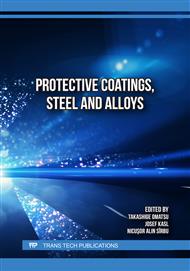p.13
p.23
p.31
p.39
p.45
p.53
p.63
p.69
p.77
Microstructural Evolution and Mechanical Behaviour of AlCrFeNiCu High Entropy Alloy Doped with Ti
Abstract:
High-entropy alloys (HEAs) have garnered significant attention due to their exceptional properties, such as high strength, hardness, corrosion resistance, and excellent formability, which present promising opportunities for energy-related applications. This study successfully synthesized a Ti-doped AlCrFeNiCu high-entropy alloy (HEA) using the laser additive manufacturing (LAM) technique, with potential applications in energy materials. The effects of Ti doping (1 at% and 3 at%) on the mechanical properties and microstructural development of the AlCrFeNiCu HEA were systematically examined. Microstructural analysis using scanning electron microscopy with energy dispersive spectroscopy (SEM/EDS) identified a dual-phase structure comprising BCC and FCC solid solutions. An Instron universal testing machine and Vickers microhardness (HVN) testing were utilized to evaluate mechanical properties. The findings indicated that although compressive strength diminished with elevated Ti content, Ti enhanced the microhardness of the alloy. The findings indicate the potential applications of Ti-doped AlCrFeNi Cu HEAs in energy sectors, such as components for concentrated solar power systems, nuclear reactors, and advanced gas turbines, which require materials capable of withstanding elevated temperatures, mechanical stress, and corrosive environments. The tailored mechanical and microstructural properties of this HEA position it as a viable candidate for enhancing the longevity and efficiency of energy systems operating under challenging conditions.
Info:
Periodical:
Pages:
53-59
Citation:
Online since:
October 2025
Price:
Сopyright:
© 2025 Trans Tech Publications Ltd. All Rights Reserved
Share:
Citation:


